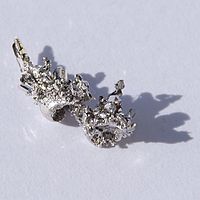
Photo from wikipedia
A polymeric catalytic membrane was previously prepared that showed remarkable efficiency for Suzuki-Miyaura C-C cross-coupling in a flow-through configuration. A mathematic model was developed and fitted to the experimental data… Click to show full abstract
A polymeric catalytic membrane was previously prepared that showed remarkable efficiency for Suzuki-Miyaura C-C cross-coupling in a flow-through configuration. A mathematic model was developed and fitted to the experimental data to understand the significant apparent reaction rate increase exhibited by the catalytic membrane reactor compared to the catalytic system under batch reaction conditions. It appears that the high palladium nanoparticles concentration inside the membrane is mainly responsible for the high apparent reaction rate achieved. In addition, the best performance of the catalytic membrane could be achieved only in the forced flow-through configuration, that, conditions permitting to the reactants be brought to the catalytic membrane by convection. © 2016 American Institute of Chemical Engineers AIChE J, 63: 698–704, 2017
Journal Title: Aiche Journal
Year Published: 2017
Link to full text (if available)
Share on Social Media: Sign Up to like & get
recommendations!